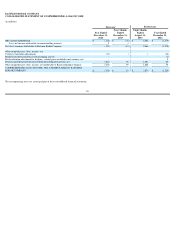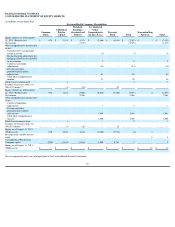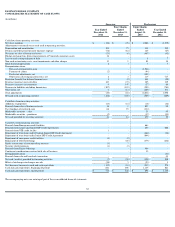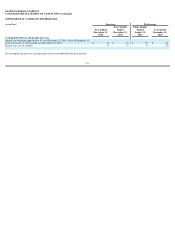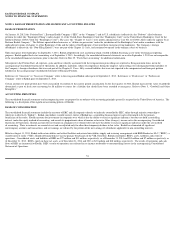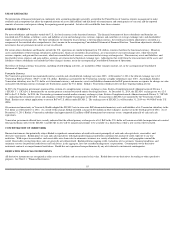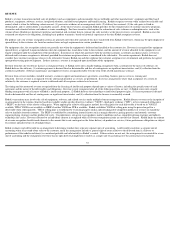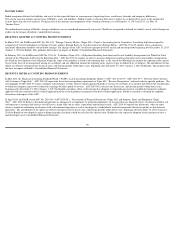Kodak 2014 Annual Report Download - page 60
Download and view the complete annual report
Please find page 60 of the 2014 Kodak annual report below. You can navigate through the pages in the report by either clicking on the pages listed below, or by using the keyword search tool below to find specific information within the annual report.
REVENUE
Kodak’s revenue transactions include sales of products (such as components and consumables for use in Kodak and other manufacturers’ equipment and film based
products); equipment; software; services; integrated solutions; and intellectual property and brand licensing. Kodak recognizes revenue when realized or realizable and
earned, which is when the following criteria are met: (1) persuasive evidence of an arrangement exists; (2) delivery has occurred; (3) the sales price is fixed or
determinable; and (4) collectability is reasonably assured. At the time revenue is recognized, Kodak provides for the estimated costs of customer incentive programs,
warranties and estimated returns and reduces revenue accordingly. For those incentives that require the estimation of sales volumes or redemption rates, such as for
volume rebates, Kodak uses historical experience and internal and customer data to estimate the sales incentive at the time revenue is recognized. Kodak accrues the
estimated cost of post-sale obligations, including basic product warranties, based on historical experience at the time Kodak recognizes revenue.
For product sales, the revenue recognition criteria are generally met when title and risk of loss have transferred from Kodak to the buyer, which may be upon shipment or
upon delivery to the customer site, based on contract terms or legal requirements in certain jurisdictions.
For equipment sales, the recognition criteria are generally met when the equipment is delivered and installed at the customer site. Revenue is recognized for equipment
upon delivery as opposed to upon installation when the equipment has stand-alone value to the customer, and the amount of revenue allocable to the equipment is not
legally contingent upon the completion of the installation. In instances in which the agreement with the customer contains a customer acceptance clause, revenue is
deferred until customer acceptance is obtained, provided the customer acceptance clause is considered to be substantive. For certain agreements, Kodak does not
consider these customer acceptance clauses to be substantive because Kodak can and does replicate the customer acceptance test environment and performs the agreed
upon product testing prior to shipment. In these instances, revenue is recognized upon installation of the equipment.
Revenue from the sale of software licenses is recognized when (1) Kodak enters into a legally binding arrangement with a customer for the license of software; (2)
Kodak delivers the software; (3) customer payment is deemed fixed or determinable and free of contingencies or significant uncertainties; and (4) collection from the
customer is probable. Software maintenance and support revenue is recognized ratably over the term of the related maintenance contract.
Revenue from services includes extended warranty, customer support and maintenance agreements, consulting, business process services, training and
education. Service revenue is recognized over the contractual period or as services are performed. In service arrangements where final acceptance of a system or
solution by the customer is required, revenue is deferred until all acceptance criteria have been met.
The timing and the amount of revenue recognized from the licensing of intellectual property depend upon a variety of factors, including the specific terms of each
agreement and the nature of the deliverables and obligations. Revenue is only recognized after all of the following criteria are met: (1) Kodak enters into a legally
binding arrangement with a licensee of Kodak’s intellectual property, (2) Kodak delivers the technology or intellectual property rights, (3) licensee payment is deemed
fixed or determinable and free of contingencies or significant uncertainties, and (4) collection from the licensee is reasonably assured.
Kodak's transactions may involve the sale of equipment, software, and related services under multiple element arrangements. Kodak allocates revenue at the inception of
an arrangement to the various elements based on available vendor specific objective evidence (“VSOE”), third-party evidence (“TPE”), or best estimated selling price
(“BESP”) on the basis of the relative selling price. When applying the relative selling price method, the selling price for each deliverable is based on its VSOE if
available, TPE if VSOE is not available, or BESP if neither VSOE nor TPE is available. Kodak establishes VSOE of selling price using the price charged for a
deliverable when sold separately. TPE of selling price is established by evaluating largely similar and interchangeable competitor products or services in standalone
sales to similarly situated customers. The BESP is established by considering internal factors such as margin objectives, pricing practices and controls, customer
segment pricing strategies and the product life cycle. Consideration is also given to geographies, market conditions such as competitor pricing strategies and industry
technology life cycles. Revenue allocated to an individual element is recognized when all revenue recognition criteria are met for that element. Kodak limits the amount
of revenue recognition for delivered elements to the amount that is not contingent on the future delivery of products or services, future performance obligations or subject
to customer-specified return or refund privileges.
Kodak evaluates each deliverable in an arrangement to determine whether they represent separate units of accounting. A deliverable constitutes a separate unit of
accounting when it has stand-alone value to the customer, and if the arrangement includes a general right of return relative to the delivered item(s), delivery or
performance of the undelivered item(s) is considered probable and substantially in Kodak’s control. If these criteria are not met, the arrangement is accounted for as one
unit of accounting and the recognition of revenue occurs upon delivery/completion or ratably as a single unit of accounting over the contractual service period.
57



